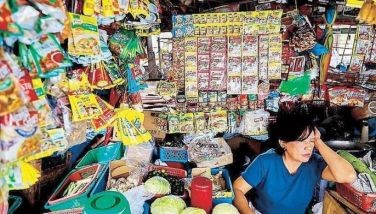S&P maintains stable outlook on RP banks
January 19, 2006 | 12:00am
International credit rating outfit Standard and Poor’s (S&P) said yesterday it is keeping its stable outlook on the banking sector in the Philippines while noting that its risk profile remains high.
The stable outlook takes note that "the growth in non-performing assets (NPAs) has not only been arrested but also reversed" to 9.3 percent of gross loans in June, from 13.6 percent in the previous year, the US-based agency said in a regional report.
While noting that the ratio remained high by international standards, it also acknowledged the banks’ efforts to improve asset quality.
However, it said "the industry’s risk profile remains high, reflecting a weak operating environment.
"Although profitability improved in 2005, this was due mainly to trading gains from Treasury activities, predominantly from the sale of high-yielding government securities."
On the minus side, the industry remains fragmented with numerous small, financially weak and undercapitalized lenders despite central bank efforts to prod it into consolidation, it said.
The banks’ investment portfolio accounted for 31.7 percent of total assets, reflecting limited lending opportunities "because many companies with good credit quality have minimal borrowing programmes."
This reliance on trading gains "renders the banks’ revenues more vulnerable to interest-rate volatility."
S&P also said that the prospects for bank ratings in the Asia Pacific region are stable as credit profiles improve due to stronger economies and continuing structural reforms.
"Most banking systems in the Asia Pacific region have improved their credit profiles, thanks to stable economic conditions and continuing structural improvements," Ping Chew, a credit analyst with the agency, said.
"In the next few years, banks should continue with these improvements, although the pace of such improvements may be moderated by risks on the horizon."
The risks include higher oil prices and rising interest rates, which could affect the broader economy, he said.
Banks in India, Indonesia and China are benefiting from favourable economic conditions, said Ryan Tsang, another credit analyst from the agency.
"Japanese banks are reporting some meaningful profit figures, Korean banks are improving their risk management techniques and in Taiwan, the regulatory regime appears to be changing for the better, although politics... may prove a stumbling block," Tsang said.
Bank rating upgrades rose significantly in 2005, with the average grade of Asia Pacific lenders climbing half a notch from "BBB" at the start of the year.
A "BBB" rating means a borrower has adequate capacity to meet its financial commitments but a deterioration of the economy or other circumstances is more likely to weaken its ability to repay borrowings.
For 2006, credit rating improvements are likely to be "slower and more incremental," Standard and Poors said, as many banks have already implemented improvements including cutting their non-performing loans.
"Structural improvements in banks’ income profiles mean that profitability of Asian banking systems will be largely sustained at current levels and the strengthening of risk management practices will continue at a quicker pace," said Ritesh Maheshwari, another credit analyst for the company.
The stable outlook takes note that "the growth in non-performing assets (NPAs) has not only been arrested but also reversed" to 9.3 percent of gross loans in June, from 13.6 percent in the previous year, the US-based agency said in a regional report.
While noting that the ratio remained high by international standards, it also acknowledged the banks’ efforts to improve asset quality.
However, it said "the industry’s risk profile remains high, reflecting a weak operating environment.
"Although profitability improved in 2005, this was due mainly to trading gains from Treasury activities, predominantly from the sale of high-yielding government securities."
On the minus side, the industry remains fragmented with numerous small, financially weak and undercapitalized lenders despite central bank efforts to prod it into consolidation, it said.
The banks’ investment portfolio accounted for 31.7 percent of total assets, reflecting limited lending opportunities "because many companies with good credit quality have minimal borrowing programmes."
This reliance on trading gains "renders the banks’ revenues more vulnerable to interest-rate volatility."
S&P also said that the prospects for bank ratings in the Asia Pacific region are stable as credit profiles improve due to stronger economies and continuing structural reforms.
"Most banking systems in the Asia Pacific region have improved their credit profiles, thanks to stable economic conditions and continuing structural improvements," Ping Chew, a credit analyst with the agency, said.
"In the next few years, banks should continue with these improvements, although the pace of such improvements may be moderated by risks on the horizon."
The risks include higher oil prices and rising interest rates, which could affect the broader economy, he said.
Banks in India, Indonesia and China are benefiting from favourable economic conditions, said Ryan Tsang, another credit analyst from the agency.
"Japanese banks are reporting some meaningful profit figures, Korean banks are improving their risk management techniques and in Taiwan, the regulatory regime appears to be changing for the better, although politics... may prove a stumbling block," Tsang said.
Bank rating upgrades rose significantly in 2005, with the average grade of Asia Pacific lenders climbing half a notch from "BBB" at the start of the year.
A "BBB" rating means a borrower has adequate capacity to meet its financial commitments but a deterioration of the economy or other circumstances is more likely to weaken its ability to repay borrowings.
For 2006, credit rating improvements are likely to be "slower and more incremental," Standard and Poors said, as many banks have already implemented improvements including cutting their non-performing loans.
"Structural improvements in banks’ income profiles mean that profitability of Asian banking systems will be largely sustained at current levels and the strengthening of risk management practices will continue at a quicker pace," said Ritesh Maheshwari, another credit analyst for the company.
BrandSpace Articles
<
>
- Latest
- Trending
Trending
Latest
Trending
Latest
Recommended
































